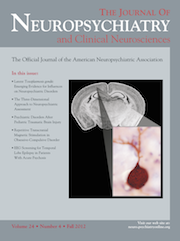Long-Term Vagus Nerve Stimulation for Severe Refractory Depression: A Case Study With a Six-Year Follow-Up
To the Editor: Major depression is one of the most common ailments, affecting about 18 million people in the United States. According to various sources, from 15% to 33% of major-depression patients do not respond to at least one or more adequate treatment regimens.1,2 Treatment-resistant depression (TRD) is one of the most difficult problems encountered by clinicians. In 2005, vagus nerve stimulation (VNS) was approved by the U.S. Food and Drug Administration for patients with chronic or recurrent depression who failed to respond to at least four antidepressant interventions. Although clinical trials have been done on the efficacy of VNS on TRD patients,3–8 the long-term effects of VNS have rarely been reported. Here, we report a case of severe TRD with VNS treatment for 6 years, showing its good tolerability and efficacy in this patient.
Case Report
A 38-year-old woman suffered from severe major depression, general anxiety disorder, borderline personality disorder, posttraumatic stress disorder with childhood sexual trauma, frequent pseudo-seizures, and migraines since she was 20 years old. She had been treated with fluoxetine, citalopram (standard and long-acting), eszopiclone, amitriptyline, bupropion, MAOIs, mirtazapine, venlafaxine, and duloxetine for her severe depression, but none were effective. Only sertraline alleviated her depression slightly. She had also been treated 10 times with electroconvulsive therapy (ECT) for major depression, but did not respond well. She had had 10 psychiatric admissions for severe depression, with a suicidal attempt and suicidal ideation, before 2005.
In December 2005, she underwent placement of a vagal nerve stimulator for her refractory depression. After the placement, she reported that her depression “immediately got better” and that she felt “totally different.” Since then, her mood has been stabilized and she has seldom experienced depression. At the outset, the settings of the stimulator were: output current, 2.25 mA; signal frequency, 30 Hz; and pulse width 500 microseconds. Signal time was 30 seconds on and 5 minutes off.
Her vagal nerve stimulator worked well until January 2011 when she had a thorough breast examination. She was palpated and massaged over the place where the vagal nerve stimulator was placed in the left upper anterior chest. Since then, she has had a "shock" feeling going to her left chest and left arm. She had involuntary muscle movements and extreme headaches, primarily in the left occipital nerve and in the left temporal auricular nerve areas. Her psychiatrist was concerned that one of the leads was displaced at that time. These symptoms disappeared after the signal frequency was decreased from 30 Hz to 20 Hz and the pulse width was decreased from 500 to 250 microseconds.
Over the 6 years since the stimulator was placed, she has rarely felt depressed, sometimes mildly depressed, and has never had suicidal ideation. Also, the vagus nerve stimulator reduced her anxiety levels. She has had fewer pseudoseizures, and her sleep has improved. The only side effect is that sometimes the volume of her voice can increase or decrease, but she admits that it does not disturb her very much. Currently, she feels normal and does not feel depressed. Her current medicines are sertraline 100 mg qhs for depression, topiramate 200 mg qd for headache and seizure, levetiracetam 1,000 mg qhs for her seizures, and zolpidem 10 mg qhs for sleep.
Discussion
TRD is a chronic, life-threatening illness that has failed to respond to multiple treatments. VNS has recently been approved as a therapy for refractory depression. In clinical trials, VNS efficacy is typically not seen for 6–12 months and therefore cannot be considered an acute treatment for TRD.3–8 However, the patient in this case study responded very quickly and felt much less depressed soon after the stimulator was placed. Although clinical trials have been done on the efficacy of VNS on TRD patients, the long-term effects of VNS (more than 2 years) has rarely been reported.3–8 In this case report with a 6-year follow-up of VNS, the patient has rarely experienced the severe depression typical of her pre-VNS period, and has shown very good tolerability. However, more case reports and clinical data are needed to evaluate the long-term efficacy of the prevention of relapse and recurrence of TRD by VNS.
The most common complaints reported for VNS were a hoarse voice, tickle in the throat, dyspnea, difficulty swallowing, neck pain, paresthesia, emesis, laryngospasms, dyspepsia, infected wounds, and palpitations.7,8 In this patient, the only side effect before the lead was out of position was that her voice would increase or decrease in volume. This kind of side effect has not been reported before. The experience of this patient has demonstrated that with the good tolerability, relatively long battery life, and the beneficial effects, VNS may find its role as a long-term intervention for treatment of patients with severe TRD.
1 : Definition, assessment, and staging of treatment-resistant refractory major depression: a review of current concepts and methods. Can J Psychiatry 2007; 52:46–54Crossref, Medline, Google Scholar
2 : Treatment-resistant depression. J Clin Psychiatry 2006; 67(Suppl 6):16–22Medline, Google Scholar
3 : Two-year outcome of vagus nerve stimulation in treatment-resistant depression. J Clin Psychopharmacol 2010; 30:273–281Crossref, Medline, Google Scholar
4 : A one-year comparison of vagus nerve stimulation with treatment as usual for treatment-resistant depression. Biol Psychiatry 2005; 58:364–373Crossref, Medline, Google Scholar
5 : Two-year outcome of vagus nerve stimulation (VNS) for treatment of major depressive episodes. J Clin Psychiatry 2005; 66:1097–1104Crossref, Medline, Google Scholar
6 : Effects of 12 months of vagus nerve stimulation in treatment-resistant depression: a naturalistic study. Biol Psychiatry 2005; 58:355–363Crossref, Medline, Google Scholar
7 : Effectiveness and safety of vagus nerve stimulation for severe treatment-resistant major depression in clinical practice after FDA approval: outcomes at 1 year. J Clin Psychiatry 2011; 72:1376–1382Crossref, Medline, Google Scholar
8 : Vagus nerve stimulation (VNS) for treatment-resistant depression: efficacy, side effects, and predictors of outcome. Neuropsychopharmacology 2001; 25:713–728Crossref, Medline, Google Scholar



